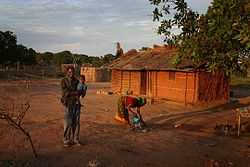Makhuwa language
| Makhuwa | |
|---|---|
| Emakuana | |
| Native to | Mozambique, Tanzania, Malawi |
| Ethnicity | Makua |
Native speakers | 6.6 million (2006)[1] |
| Language codes | |
| ISO 639-3 |
Variously: vmw – Central Makhuwa mgh – Makhuwa-Meetto vmk – Makhuwa-Shirima kzn – Kokola llb – Lolo mny – Manyawa vmr – Marenje tke – Takwane xmc – Makhuwa-Marrevone xsq – Makhuwa-Saka |
| P.31[2] | |

The Makhuwa language, Emakhuwa (also spelled Makua and Macua) is the primary Bantu language of northern Mozambique. It is spoken by 4 million Makua people, who live north of the Zambezi River, particularly in the province of Nampula. It is the most populous indigenous language of Mozambique. The province of Nampula has practically no other ethnic group.[3] Apart from the languages which belong to the same group, eMakhuwa is distinguished from other Bantu languages by the loss of consonant + vowel prefixes in favour of e- - compare epula, "rain", with Tswana pula.
Vowels used are i, e, a, o, u, which is unusually sparse for a Bantu language: long and short varieties need to be distinguished:
- omala - to finish
- omaala - to paste, stick
- omela - to sprout, bud
- omeela - to share out
The consonants are more complex: postalveolar tt and tth exist, both p and ph are used, and both x (English "sh") and h, while x varies with s. Regionally there is also θ (the "th" of English "thorn" or the Welsh "th"), ð (the "th" of English "seethe" and "dd" of Welsh "eisteddfod"), z and ng. In eLomwe, for instance, the -tt- of eMakhuwa is represented by a "ch" as in English "church".[3]
Makhuwa is closely related to Lomwe.
Dialects
The names of the dialects vary in different sources. The shibboleth or distinctive variant in the dialects is the treatment of the s:
- eSamgagi dialect: odhiva
- eSangagi dialect: θtiva
- eSaaka dialect: ociva
- eNahara dialect: oziva - all meaning "agreeable, pleasant" [3]
Maho (2009) lists the following dialects:[2]
- Central Makhuwa (3.1 million)
- Meetto (Metto) (1.3 million, including Ruvuma)
- Chirima (Shirima) (1.5 million, including subdialects Kokola, Lolo, Manyawa, Marenje, Takwane)
- Marrevone (Coastal Makhuwa; 460,000 including eNahara)
- eNahara (Naharra)
- eSaka (Saka, 210,000)
- Ruvuma Makhuwa (Tanzanian Makhuwa, including subdialects Imithupi, Ikorovere)
Mutual intelligibility between these is limited. Central Makhuwa ("Makhuwa-Makhuwana") is the basis of the standard language. Ethnologue lists Central Makhuwa, Meetto–Ruvuma, Marrevone–Enahara, and Esaka as separate languages, and Chirima as six languages.
The population figures are from Ethnologue for 2006. They tally 3.1 million speakers of Central Makhuwa and 3.5 million of the other varieties, though the Ethnologue article for Central Makhuwa covers Marrevone and Enahara, so these might be double counted.
Reading matter in eMakhuwa
Muluku Onnalavuliha Àn'awe - Ipantte sikosolasiwe sa Biblia ("God speaks to his children" - extracts from the Scriptures for children) Aid to the Church in Need. Edição em Macúa / eMakhuwa) Editorial Verbo Divino, Estella, Navarra, 1997.
References
- ↑ Central Makhuwa reference at Ethnologue (17th ed., 2013)
Makhuwa-Meetto reference at Ethnologue (17th ed., 2013)
Makhuwa-Shirima reference at Ethnologue (17th ed., 2013)
Kokola reference at Ethnologue (17th ed., 2013)
Lolo reference at Ethnologue (17th ed., 2013)
Manyawa reference at Ethnologue (17th ed., 2013)
(Additional references under 'Language codes' in the information box) - ↑ 2.0 2.1 Jouni Filip Maho, 2009. New Updated Guthrie List Online
- ↑ 3.0 3.1 3.2 Relatório do I Seminário sobre a Padronização da Ortografia de Línguas Moçambicanas. NELIMO, Universidade Eduardo Mondlane, 1989.
- Oliver Kröger (2005), Report on a Survey of Coastal Makua Dialects (SIL International)